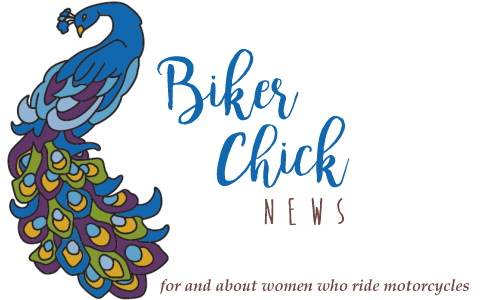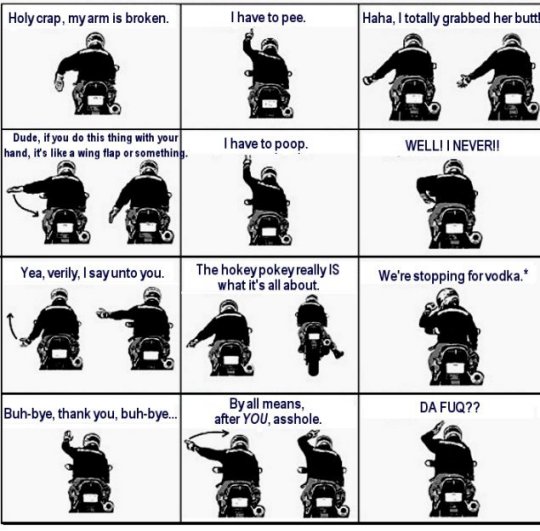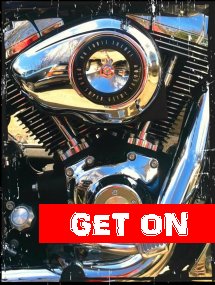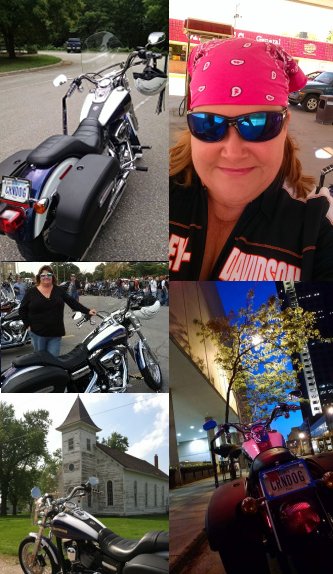How (and when) to improve your motorcycle riding skills
by Corn Dog on July 10, 2017
in Riding Tips
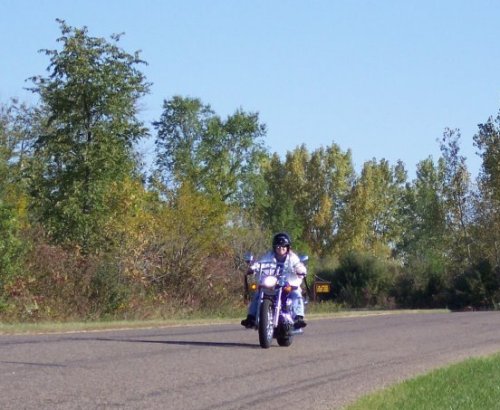
There was a discussion some months ago on Twitter that centered around the notion of being a “serious rider:” Are you a serious rider? What makes one a serious rider? How can non-serious riders (deemed “occasional riders” by the group moderator) become more serious, and what can serious riders do to encourage occasional riders to become more serious?*
The group seemed to agree that a serious rider is someone who rides more than just on weekends, and makes a conscious effort to improve their riding skills. At this point it became clear to me that I am not, apparently, a serious rider.
Well here’s my truth: I’d love to feel so confident in my riding skills that I know I could think and react quickly enough when needed to prevent serious injury (or worse) to myself. But at this time, apart from whatever skill development comes from simply riding as often as I can, I rely almost exclusively on the fervent hope that I will come home from every ride in one piece, without having tested my emergency skills at all.
Realizing that the above is pretty much the “wing and a prayer” method, and although I most certainly bristled at this group’s attempt to classify people into types of riders (not to mention implying that one type of rider should strive to become the other type), I did ultimately ask myself a serious question: how might I specifically set out to improve my riding skills?
Parking lot practice, maybe? Sure I could get out there in an empty parking lot and practice my tight circles and quick stops, but this seems like little more than planning a date to dump my bike.
I think the better answer is actually classes. After all, if a sanctioned class including plenty of range time is considered the best way to learn the basics of riding, it stands to reason that it’s also the best way to learn and practice advanced skills.
With that in mind, here are some ideas for classes that are out there, available to anyone who wishes to make a conscious effort to improve their skills and therefore, become a more “serious rider.”
- Motorcycle Safety Foundation (MSF) – The MSF Basic RiderCourse is of course, the class that gets you your motorcycle license when you complete it successfully. But the MSF offers a wide variety of advanced classes, including the Advanced RiderCourse, the Street RiderCourse, and their Ultimate Bike Bonding Course. Their website has complete information on all of these.
- Some Harley-Davidson dealerships also offer “new rider” and “skilled (experienced) rider” courses. You are not required to be a Harley owner to take these classes, but not every dealership offers them. Check with your local or regional dealer to see what’s offered.
- You can also try private instruction such as that offered by Ride Like A Pro – interesting because it focuses on the techniques of slow-speed control that are taught to police teams. Indeed, any program offering “civilian motorcop training” will likely focus on slow-speed maneuvers such as cone weaves, the 180-turn box, figure 8’s, raising a downed motorcycle, and more. The course offered by Midwest Motorcycle Training also appears to be fairly comprehensive.
- Some of the “serious riders” I’ve encountered also recommend learning the basics of dirt track riding, to give you some skills with handling less-than-perfect traction. This seems to me to be not only a good idea… but fun! (Except for the inevitable broken arm, of course.) The Midwest Motorcycle Training course linked above seems to include this in their motorcop training, but certainly there are many other resources.
- Another class that might be helpful, though it doesn’t improve riding skills per se, is accident scene management. This type of training, such as that offered by Road Guardians, comes with a keen level of responsibility for sure, but just think about the level of aid and comfort you would be able to offer to an injured rider if you knew how to secure a scene and keep them calm while you wait for medical help to arrive. Our local Harley dealership has offered this course numerous times.
I’m certain these are just a few of the opportunities to consciously set about improving your skills and therefore become a “serious rider” – which you should do for yourself, not because some random online chat group makes you feel inferior.
If you know of other opportunities or have other suggestions, please feel free to share by leaving a comment – just click the ‘comments’ link at the top of this article!
*I might simply be overly sensitive, but just a week later this same group discussed what type of gear everyone wears when riding. And they were pretty quick to jump on the gal who admitted up front that she dresses for the weather and not for the crash. Perhaps this is just not the right chat group for me.
Start a motorcycle in neutral, or in first gear?
by Corn Dog on May 29, 2016
in Riding Tips
I was reading an article online the other day in which the author laid out her motorcycle start-up sequence. Because I am a believer in doing my start-up tasks in the same order every time (so I don’t miss something important), I decided to write down my own sequence in case it might be helpful for someone else.
I noticed when I did this that there was one notable difference between my sequence and hers: she starts her bike in neutral, and I start mine in first gear.
I have no idea where I picked up the habit of starting my bike in first, but i immediately wondered if one method was recommended over the other.
Turns out, yes. And it’s not mine.
I looked for this information a few different ways: I polled my knowledgeable tribe of biker pals… I looked online in Harley Davidson support forums… and (HORRORS) I broke open my owner’s manual for a quick review of HD’s “official” recommendation.
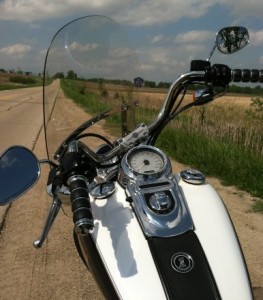 Based on all that exhaustive research, although I’ve been starting my bike in first gear for as long as I can remember, I am changing my ways and will henceforth be starting in neutral.
Based on all that exhaustive research, although I’ve been starting my bike in first gear for as long as I can remember, I am changing my ways and will henceforth be starting in neutral.
The obvious benefit to this is, in neutral, I don’t have to worry about the bike lurching forward and possibly getting away from me. (That’s assuming I am absolutely certain it’s in neutral. )
Or, as my friend Shirley said when she responded to my non-scientific poll on this question: “I always start in neutral. Why? So I don’t forget and run into the garage wall!”
Aside from this bit of common sense, there’s also a mechanical reason for starting the motorcycle in neutral, especially when the bike is cold: starting in neutral allows the fluids and clutch plates to warm up before you attempt to engage them by putting the bike in gear.
This is helpful because when the bike is cold, the fluids have also cooled and settled away somewhat from the parts they are protecting. The clutch plates are therefore likely to be somewhat stuck together due to the suction created from this cooling and settling.
If you start the bike in first gear, you’re attempting to unstick those suctioned plates without benefit of first warming the fluids.
Think about the viscosity (resistance to flow) of other cold fluids vs. their warmed-up counterparts. You know the old expression, “slower than molassses in January”? That’s not just something a pioneer hillbilly made up one day while sitting on his front porch, waiting for his kin to come along with a washboard so they could start the jug band jam. It’s actually a perfect illustration of how temperature affects viscosity: molassses is slow in January because it’s cold. And cold impedes flow.
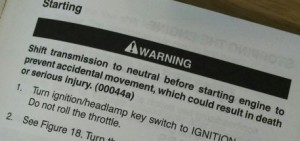 For motorcycles, flow (of fluids) is critical for smooth operation. When you start the bike in first gear, you’re asking moving mechanical parts to unstick from and engage with each other while surrounded by cold, poorly-flowing fluids. You are causing unnecessary wear and tear on those parts. You are being unreasonable. And you are annoying the hell out of your motorcycle.
For motorcycles, flow (of fluids) is critical for smooth operation. When you start the bike in first gear, you’re asking moving mechanical parts to unstick from and engage with each other while surrounded by cold, poorly-flowing fluids. You are causing unnecessary wear and tear on those parts. You are being unreasonable. And you are annoying the hell out of your motorcycle.
Stop annoying your motorcycle, and start your motorcycle in neutral. You’ll improve its overall performance, and you’ll (probably) avoid running into the garage wall.
Win-win!
Park for the exit: tips for parking your motorcycle
by Corn Dog on May 14, 2016
in Riding Tips
Look where you want to go.
Scan the road at least 12 seconds ahead.
Slow, Look, Press, Roll.
These are some of the best pieces of advice you’ll hear for riding and controlling your motorcycle. One of the least-discussed aspects of riding, however, is what happens at the end of the ride: parking!
And, while it’s tempting to simply cruise in to your destination and hop off the bike, it’s far better to actually put some careful thought into your stoppage. Because quite honestly, how and where you park will determine the ease with which you eventually leave. So I’ve got one more piece of advice for you to consider:
Park for the exit.
What I mean is, park your bike with leaving – not arriving – in mind. Because truly, how you park your bike determines what challenges or problems you’re going to have when it’s time to leave. Here are some tips for smart parking.
Park level. Seriously, do yourself a favor and make this a top priority in parking your bike. Whenever you can, pick a level spot so you don’t have to do a drastic lean to one side when preparing to leave.
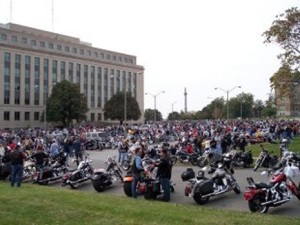 Park solid. Mud, gravel, and even hot-baked blacktop can cause your bike to sink where it sits, especially considering that all the weight of the bike is transferred to that tiny contact point at the end of your kickstand when you’re parked. You can improve this situation by re-distributing the weight of the bike, using a parking disc or small piece of wood placed under the end of the stand.
Park solid. Mud, gravel, and even hot-baked blacktop can cause your bike to sink where it sits, especially considering that all the weight of the bike is transferred to that tiny contact point at the end of your kickstand when you’re parked. You can improve this situation by re-distributing the weight of the bike, using a parking disc or small piece of wood placed under the end of the stand.
Nose-out. Taking the time to park “nose out” has saved me many headaches when leaving a parking spot. What I do is pull into a parking lot, quickly scan to identify my target space, and then make a U-turn in front of it so I can back in – assuming, of course, that doing so leaves me level and solid. Where this really saves me is in a space where the parking spot slants downward toward the curb. If I’m nose-out, I don’t have to try to back the bike out and up an incline.
Stick together. In a group, as the ride leader, I try to scope out an area big enough in the parking lot so that our entire group can park together. This ensures that we’re more likely to be able to leave as a group and less likely to inadvertently leave someone behind.
Share a space. This is more of a courtesy shown to other vehicles. A single parking space is almost always big enough for two bikes, especially if one parks a little ahead of the other. If I’m at a very busy venue, I try to occupy as little space as possible if I can do so without compromising my parking safety or that of my spotmate. It might go without saying, but I don’t actually put myself into a space with another bike if I don’t know that person. I only share a space with my own riding companions.
Shut down, lock up. I have a shut-down procedure (and conversely, a start-up procedure) that I go through almost every time I get off the bike. This involves locking my ignition as well as my front forks, removing gear, etc. etc. Although it may seem a little OCD (or even overkill) to do things the same way each and every time, I’ve found that practicing a consistent shut-down sequence ensures that I won’t miss performing a really critical task like… ahem… putting the kickstand down.
These are my tips for smart, safe parking. What else would you add to this list?
It’s weird when I’m not in the lead
by Corn Dog on August 9, 2013
in Riding Tips
One of the things about the recent Divas ride to Haverhill that was really different – besides the unseasonably cool July weather – was the fact that I was not the one leading the ride. It’s unusual (though certainly not objectionable!) for me to be situated elsewhere in the pack, and it creates a really different riding experience.
Of course, the ride leader has the responsibility for plotting the route and keeping the group together as best she can, and getting the group re-united if separation occurs.
But the members of the pack have a responsibility, too, and it’s one I admit I haven’t had much experience with. It’s the responsibility to pay attention to what the rider ahead of me is doing.
Perhaps it was simply the novelty of not being the ride leader that turned me into a slacker. But whatever the reason, more than once, I found myself gawking at the scenery… blissfully unaware that my pal Dakota Coyote actually had her blinker on, signaling for an upcoming turn! In these butt-puckering instances, I not-so-blissfully hit the brakes, said a quick “Oh shit,” and managed to make the turn.
But not without kicking myself for shirking my duty! For you see, it’s not just my duty to pay attention for my own sake. It’s also my duty for the benefit of the rider behind me, so she knows where we’re going too, and so I don’t cause an accident behind me!
And here’s a tip that I haven’t really incorporated into my own “ride leader” repertoire, but will try to remember: hand signals REALLY help! Now I’m religious (pious, even) about using my electronic turn signals, wagging my foot when there’s something in the road, or pointing to one side if there’s a potential hazard such as a car inching its way forward from a stop sign. But I don’t typically use directional hand signals, and yet I noticed: while I might have easily missed Coyote’s blinking turn signal, I couldn’t help but see her arm hanging out, pointing left… or bobbing over her head, pointing right!
So the simple lesson is, pay attention! Responsibility to yourself and other riders doesn’t take a holiday just because you’re not leading the pack!
And now, for your further reading and purely as a public service, here are some common hand signals every rider should know:
*haha, no we’re not. Of COURSE we don’t drink and ride.
Friday Fives: Road hazards for motorcycles are not all deer and pot-holes
by Corn Dog on May 9, 2013
in Friday Fives, Riding Tips
 As if its not bad enough that most drivers these days seem to be dangerously distracted by cell phones, dashboard toys, and/or a sense of self-righteous road rage, motorcyclists also have a whole slew of other potential hazards to manage. Some are commonly discussed, such as deer or rain-slicked roads. But there’s a wide variety of other situations, objects and circumstances that can cause serious problems – for any driver, really, but with likely more dire consequences for people on motorcycles. Here are a few I’ve personally encountered – you probably have too.
As if its not bad enough that most drivers these days seem to be dangerously distracted by cell phones, dashboard toys, and/or a sense of self-righteous road rage, motorcyclists also have a whole slew of other potential hazards to manage. Some are commonly discussed, such as deer or rain-slicked roads. But there’s a wide variety of other situations, objects and circumstances that can cause serious problems – for any driver, really, but with likely more dire consequences for people on motorcycles. Here are a few I’ve personally encountered – you probably have too.
1. Four-legged friends – Riding through a deer-laden gauntlet isn’t the only way animals can pose a problem for a motorcycle. Be on the lookout for overly-enthusiastic dogs charging out from a farmyard… determined crows picking morsels from a fresh hunk of roadkill… wild turkeys lumbering up from the shoulder… or even turtles. Yes, turtles. Although it seems they move slow enough to safely avoid, it’s a little unnerving to spot what appears from many yards away to be an Army helmet in the middle of the road, only to realize that it’s actually moving and you need to assess its speed and position.
2. Road surface deterioration – It’s easy to misjudge the size of a pothole, so be wary of all of them, particularly after a rain when water disguises their true depth. But also look out for “vertical” holes – the kind that are long and narrow and run with the direction ot the bike’s travel instead of across its path. These can catch your tire and yank the bike right out from under you. Likewise any section of road with a vertical seam in it, where one section has settled lower than the other. A friend of mine once got her front tire up against the seam of uneven adjoining sections, which threw her from the bike – fortunately at a low speed. Also, man-hole covers. A hard rain can force an iron man-hole cover up out of its “seat” and onto the pavement as water rushes through the storm sewer underneath. Bad enough when you can see it laying in the road… but potentially horrible when you are riding through even just a few inches of standing water and can’t see that the iron disk – and the hole it used to cover – are in your path.
 3. Other surface issues – It’s truly a wide world out there when it comes to what can compromise the road surface. You’ll find plentiful advice about riding in the rain, along gravel, etc. But there’s a lot more to surface compromise than water or gravel. Out on the rural roads, its common to encounter a home owner astride their riding mower, throwing cut grass out onto the highway. Grass and leaves (also patches of gravel) hinder your tire’s ability to grip the road so be very cautious traveling through these patches especially when wet and/or on curves. And give that homeowner a friendly wave just for good measure. Another possibility: street paint. Have you noticed that crosswalks aren’t always just two horizontal stripes anymore? These days they can be giant blocks of solid paint spanning the width of the roadway. I’m absolutely certain these large blocks of paint slicken the surface and reduce tire grip, especially when rain-soaked. There’s one on a curve that I pass over every time I’m coming home from the north – I make sure I ride between the painted blocks.
3. Other surface issues – It’s truly a wide world out there when it comes to what can compromise the road surface. You’ll find plentiful advice about riding in the rain, along gravel, etc. But there’s a lot more to surface compromise than water or gravel. Out on the rural roads, its common to encounter a home owner astride their riding mower, throwing cut grass out onto the highway. Grass and leaves (also patches of gravel) hinder your tire’s ability to grip the road so be very cautious traveling through these patches especially when wet and/or on curves. And give that homeowner a friendly wave just for good measure. Another possibility: street paint. Have you noticed that crosswalks aren’t always just two horizontal stripes anymore? These days they can be giant blocks of solid paint spanning the width of the roadway. I’m absolutely certain these large blocks of paint slicken the surface and reduce tire grip, especially when rain-soaked. There’s one on a curve that I pass over every time I’m coming home from the north – I make sure I ride between the painted blocks.
4. Debris – We’ve all been stuck behind a construction vehicle now and then, and felt the tick-tick-tick of dirt or gravel coming off the truck. But consider that any open vehicle carrying “stuff” can pitch items large or small out into your path – from plastic grocery bags to household goods. Also pay attention to trailers, boats, or other items being towed. I’ve seen car parts come sliding off a flatbed trailer, water pouring from a boat that had recently been pulled from the lake… and, I was once traveling behind a pickup truck towing a covered boat, and the cover on the boat came up and off. Fortunately it sailed off to the side, but it certainly could have posed an interesting visibility problem for me had it come back my way. It doesn’t even have to be actual debris to be a hazard. It can be anything in the road that’s not supposed to be there. A few years ago, a drunken pedestrian stepped out in the road directly in front of my oncoming friend. Both were seriously injured in the resulting collision.
5. Optical illusions – Some hazards are not really problems in and of themselves, but they create a visibility issue. The other day we were on a road where there was a horizontal seam about every 20 feet, and every one of them was covered with black sealant. Twenty feet goes by pretty quickly on the bike, so it became a constant stream of black stripes whizzing by. It created some issues with depth perception as well as a huge visual distraction. I call this the Willy Wonka Effect because it reminds me of that annoying scene in the Gene Wilder version of the movie where they’re traveling down the chocolate river in his freaky boat with the LSD-inspired scenery. Riding in dappled sunlight can have the same Wonka effect.
As you can see, distracted drivers and deer are not our only worries while riding motorcycles. What’s the most unusual hazard you’ve ever encountered, and how “close” was the call with you and your bike? Thoughts or tips on dealing with any of the above?
Traveling? Load your bike with FLEAS!
by Corn Dog on May 20, 2011
in Riding Tips, Travel Tips
 Whether you’re already an expert, or brand spankin’ new to traveling long distances on a motorcycle, it’s important to know how to properly pack and load your bike. Your goal, of course, is to maintain the bike’s overall balance and center of gravity so that maneuvering isn’t any more difficult with the added weight of luggage and stuff.
Whether you’re already an expert, or brand spankin’ new to traveling long distances on a motorcycle, it’s important to know how to properly pack and load your bike. Your goal, of course, is to maintain the bike’s overall balance and center of gravity so that maneuvering isn’t any more difficult with the added weight of luggage and stuff.
Like every good problem-solver these days, I’ve devised an acronym to help remember how to most effectively pack the bike for a trip. So get ready to pack your bike with FLEAS!!
Forward – Keep your load forward, meaning over or in front of the rear axle when possible. A load that is too far to the rear can affect turning or braking, or cause the bike to wobble. Use common sense, of course: a tankbag, while certainly forward, should not interfere with your ability to manage steering or hand controls.
Low – Keep your load low, meaning inside saddle bags as much as possible. Of course, this isn’t always possible – just remember that a load carried on the passenger seat should not be stacked too high, and should not be allowed to shift when traveling. (When we traveled to Sturgis, I had to learn to swing my throw-over leg over the luggage bungeed to the sissy bar, but I didn’t feel like the bike was unbalanced. It felt like I had a lightweight passenger on the back.)
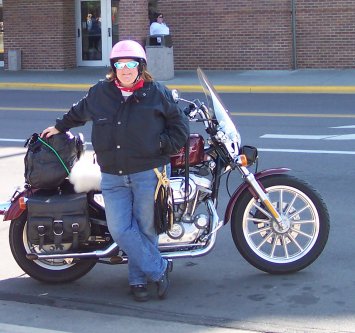
Even – Distribute weight evenly between saddlebags so the bike doesn’t want to list left or right.
Accessible – Keep important items accessible even when the bike is packed. Rain gear, cell phone, tool kit, camera… whatever is on your must-have list should be available easily when you stop for a break, so you don’t have to unpack the whole bike just to get to them.
Secure – Goes without saying you should batten down the hatches as completely as possible, especially if you have a T-bag, roll-bag, or other “loose luggage” to attach to the bike. I use multiple bungee cords, criss-crossing them over the bags and making sure they are super-snug. It’s also helpful to know your bungee plan when using multiple cords.
I hope FLEAS can help you remember how to pack for a trip… oh, I crack me up!
Tips for car drivers on sharing the road
by Corn Dog on May 20, 2010
in Riding Tips
Hat tip to Rippin-Kitten for the alert on this link!
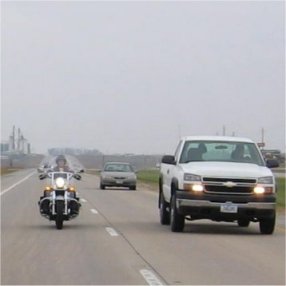 Here’s a link you can share with the cagers in your life – information from the Motorcycle Safety Foundation (MSF) on sharing the road with motorcycles, found on their new website www.forcardrivers.com
Here’s a link you can share with the cagers in your life – information from the Motorcycle Safety Foundation (MSF) on sharing the road with motorcycles, found on their new website www.forcardrivers.com
I don’t know about you, but riding a motorcycle has actually made me a better driver overall: I am more watchful, less likely to take up a distraction like talking on the phone, and I make a conscious effort to look for bikes year-round (because you never know when we’ll get a nice day in January!).
I do think, though, that most drivers forget over time whatever information they may have been given during Driver’s Ed regarding motorcycles. That’s why the MSF site is a good one, especially the Quick Tips page.
All the tips are good, but this one strikes me as something a long-time cager might “forget” over time:
Motorcyclists often adjust position within a lane to be seen more easily and to minimize the effects of road debris, passing vehicles, and wind. Understand that motorcyclists adjust lane position for a purpose, not to be reckless or show off or to allow you to share the lane with them.
I’ve had direct personal experience with drivers crowding me, or members of my merry band – in fact, last time our daughter joined us for a ride on her dad’s bike, some asshole scared her to death by following way too closely and way too aggressively. And I thought, “Are you serious? You would risk killing a dad and his daughter because you thought we were going too slow? DO YOU NOT SEE THE SLOW-MOVING CAR WE ARE ALL FOLLOWING??” (There was more to this thought-stream, but I’ll spare you the details.)
I’ll have more soon on another of the tips (the one about motorcycles and their stopping distance) – but for now, just wanted you to be sure to check out the site and use the comment section below to offer your “share the road” tips and stories.
Good tips for ride leaders
by Corn Dog on January 8, 2010
in Riding Tips
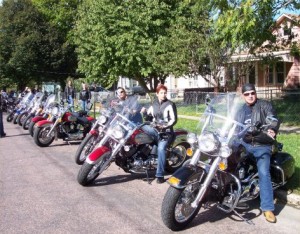 Jay’s got a strong list of tips for road captains over at Road Captain USA, and, although I’m not a sanctioned road captain I’ve led a lot of rides so thought I’d make some additions here instead of whole-posting in his comments section. (Jay, hope you don’t mind the link!)
Jay’s got a strong list of tips for road captains over at Road Captain USA, and, although I’m not a sanctioned road captain I’ve led a lot of rides so thought I’d make some additions here instead of whole-posting in his comments section. (Jay, hope you don’t mind the link!)
Most notably, two things:
First, there’s another reason to park away from the front door of the convenience store – when you get a little farther away from the entrance, you likely have more room for all the bikes in the group. You then have a better chance of getting parked in some kind of group or even loose formation for making an organized exit.
Second, I disagree that the group leader should “ride their own ride.” The group leader has to ride within their own skillset and comfort zone, for sure. But part of being the leader is keeping track of the rest of the group. and that’s not possible if you just focus on your own ride. That’s not to say the leader shouldn’t have the opportunity to enjoy the ride. But it’s important to know what’s going on with the rest of the group. I think the key is really just to find the middle ground.
Beyond these, here are a couple “tips” of my own – well, not really tips, just things I try to do when leading a group that I think make it more enjoyable.
1. I don’t abandon people just because we’ve reached the destination. I know it’s “policy” in some sanctioned riding groups that the ride ends the moment you arrive, and certainly in larger groups that’s because people want to be free to head home as meets their needs. For the kind of small-group rides I’m usually leading, it just feels like common courtesy to lead the ride home too.
2. I try to pick destinations that have food and something interesting to see. Of course, the day is mostly about the ride itself. But it’s nice to have something to explore, if even for a short time, to give everyone a break. As for the food – the logic of that just goes without saying.
If you find yourself leading rides, what are your tips? If you tend to follow, what do good leaders do that make the ride more enjoyable?
Friday Fives: 5 Skills to Practice for Safer Riding
by Corn Dog on May 15, 2009
in Friday Fives, Riding Tips
 When I took my skills test to get my license, I didn’t understand why the entire test was based on slow-speed skills. After riding awhile, I finally figured it out: It’s not about whether you can go straight down the road and shift the gears – almost anyone can learn to do that. It’s whether you can control the bike, evade obstacles, and be safe in high-traffic or large-crowd situations that makes you a really good rider.
When I took my skills test to get my license, I didn’t understand why the entire test was based on slow-speed skills. After riding awhile, I finally figured it out: It’s not about whether you can go straight down the road and shift the gears – almost anyone can learn to do that. It’s whether you can control the bike, evade obstacles, and be safe in high-traffic or large-crowd situations that makes you a really good rider.
So, having brushed the chip off my shoulder regarding the importance of slow-speed maneuvers, I thought I’d share five skills you can practice that will help you feel more confident on the road, more in control of your bike, and overall a better rider. I’ve also included at the end a few links to websites that have good practice guides if you want more tips or more exercises to practice.
1. Right-hand turn coming off a stop.
Why it’s good to practice: It’s easy to go too wide, into an oncoming traffic lane.
Your goal: Keep your bike confined to the correct lane as you make your turn.
Tips: After checking for traffic, look ahead to the point where you want to end up – NOT into the oncoming lane and NOT at the yellow line in the middle of the road. Don’t apply the front brake when making your turn or the bike will go down.
2. Left-hand turn coming off a stop.
Why it’s good to practice: It’s easy to go too wide, into the opposite curb, when turning onto a two-lane street.
Your goal: Keep your bike in the correct lane and away from the curb as you make your turn.
Tips: After checking for traffic, look ahead to the point where you want to end up – NOT at the opposite curb. Don’t apply the front brake when making your turn or the bike will go down.
3. Starting from a stop on a hill.
Why it’s good to practice: You don’t want to stall the bike or roll backwards into cars behind you when it’s your turn to come off the stop sign or red light.
Your goal: Smoothly pull away from your stop without killing the bike and with less than a foot of roll-back.
Tips: Find a low-traffic, hilly neighborhood to practice in if possible. Slowly release the clutch til you feel it grab, then give just enough throttle to move the bike forward. Also practice this by turning right or left off the stop by combining with the tight-turn tips above.
4. Sudden Stops.
Why it’s good to practice: You need to get a feel for controlling your bike in a quick stop.
Your goal: Come to as quick a stop as possible without skidding or locking the brakes.
Tips: Practice with a riding buddy so they are on hand to help if you go down or get hurt. Find an empty parking lot for practice. Ride straight, getting into second gear. Then “suddenly” apply both brakes with even but firm pressure. If you do lock the brakes, DO NOT immediately release them or you’ll be thrown high-side or low-side off the bike
5. Riding in a tight circle or Figure 8.
Why it’s good to practice: It will teach you to really control your bike, make tight turns successfully, and that “looking where you want to go” really works.
Your goal: Ride in a continuous ten-foot-wide circle or in a nicely-formed figure 8 with ten-foot-wide loops.
Tips: Watch instructional videos such as the Ride Like A Pro series to see how it’s done. Look where you want to go – looking across the circle at a point directly opposite you should take the bike in a nice tight circle. Feather your clutch for speed control; use the REAR brake, not the front.
Here are a few other resources:
http://ridemyown.com/articles/riding/index.shtml
http://motorcycleassistant.com/motorcycle-practice-exercises/
http://www.bcrider.com/practice.html
Tailgating *ssholes and you: a few coping strategies
by Corn Dog on January 18, 2008
in Riding Tips
Whenever we are out on the bikes, my husband likes to ride sweep – which means he likes to be the last rider in the line-up. (Here’s what happened when I tried riding sweep last summer.) He has said he does this because he wants to keep idiot cagers at bay – you know, the ones who insist on driving so close to the vehicle in front of them that they couldn’t possibly stop in time to avoid a rear-end collision.
I was thinking about this the other day while driving to my dad’s, and noticing one of those really huge pickup trucks that was so close on my bumper I couldn’t see his headlights in my rear-view mirror. The whole thing made me wonder what I would do if, in fact, I had someone tailgating me on the bike.
It seems to me there are a few options:
1). Tap my brakes and hope they get the hint before they actually rear-end me.
2). Give a wave or other appropriate gesture which says, “You are too close and should back off.”
3). Ride with a .38 Special tucked visibly into the back of my waistband. Good only if no cops happen to come up behind me.
4). When safe, pull off to the side and let them pass.
5). Pull up to a stoplight, shut off the bike, put the kickstand down, and walk back to the offender and ask them just what the hell they think they are doing.
Another one I’ve heard bikers talk about is to throw small objects from your pocket at the vehicle. Of course, you don’t throw your housekeys or other personal effects – you carry something specifically for this purpose. Examples might include small ball-bearings, chunks of busted ceramic material from old spark plugs, small pebbles, glass marbles, frozen peas, or even Skittles. While I can relate to the sense of glee one must get from exacting revenge in this way, it seems to me that these days you might only be provoking someone’s sense of righteous road rage.
What I usually do in the car is slow way down so I’m at least 5 mph under the speed limit, and wait for them to get impatient and go around me. I’ve never had that not work, so that’s probably what I’d do on the bike – followed by hand gestures if necessary. Or maybe even if not necessary.
How about you – what’s your best strategy for discouraging tailgaters?
